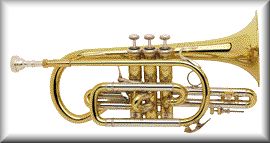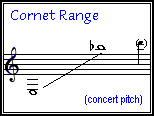
The cornet is a close relative of the trumpet. The standard instrument in brass bands is the B𝄬 cornet. Its pitch range is the same as that of a trumpet. It is the most numerous instrument in the brass band, with about a third of the players using cornets. A full brass band also includes a soprano cornet, pitched in E𝄬, which is smaller than the B𝄬 cornet.
Physical Description
The cornet is the smallest instrument in the brass band. The main tube has a moderately conical bore, gradually widening from the leadpipe to the bell flare. Most cornets have three piston valves. The instrument is usually equipped with a ring or lever on the third valve slide, and often also on the first valve slide. These are used to compensate for tuning problems which are inherent to all brass instruments.
When played, the cornet is held straight out from the lips, with the valves vertical or slightly incline to the player’s right. The valves are manipulated with the fingers of the right hand. The left hand supports the instrument. If there are compensating mechanisms, they are usually operated with the left hand.
Tone Color
The tone of the cornet is midway in color between the bright sound of the trumpet and the dark, complex tone of the flügelhorn. The relatively short air column gives the cornet good flexibility and responsiveness.

Brass arrangers and composers sometimes modify the sound quality of the cornet by specifying various kinds of mutes, which are inserted into the bell. The two most common are the straight mute and the cup mute. More subtle changes in timbre can be achieved by writing in a high or low register, varying the key, instructing the player to play with the bell close to the music stand, use of dynamics, and the presence or absence of vibrato.
Role in the Brass Band
In a brass band, the cornet supplies the principal soprano voice. This instrument occupies a position in the band similar to that of the violin in a symphony orchestra. In small groups, the cornet is almost always the principal melody instrument. However, even in small groups (such as a sextet), there are usually at least two cornet parts, with the second part supplying the alto voice.
In more complex arrangements, the cornet section is sometimes split into three or four parts. The parts are often subdivided as divisi into two, three, or more voices. Because the cornet is the highest-pitched instrument in the brass band, and because its tone is relatively bright, it is capable of “cutting through” and being heard even when the entire band is playing. The agility and speed which can be achieved by a skilled cornet player also make it a favored instrument for solo items, both with and without full band accompaniment.
Because of its small size and relatively low cost, the cornet is the instrument most often used for beginner instruction.
Cornet vs. Trumpet

Although the length of the main tube is the same on both cornets and trumpets of the same pitch, the arrangement of the tubing is different. The trumpet’s tube is straighter, with fewer curves and loops. This makes the instrument longer in terms of the distance between the player’s lips and the end of the bell. Not only does the cornet have a more complex tubing design, the tube itself is conical over a larger portion of the length. Both the complexity of the tubing and the slope of the bore influence the final sound of the instrument. The tone of the trumpet is clearer (closer to a pure sine wave). The cornet’s sound is generally more gentle and warm than that of the trumpet. Trumpeters rarely employ vibrato, but this technique is commonly used by cornetists.
Soprano Cornet
Larger bands usually include an E𝄬 soprano cornet. This instrument is pitched a perfect fourth higher than the B𝄬 cornet. Because it has the highest range in the band, it can be heard above the full band. This variant of the cornet is considered a difficult instrument to play, in part because of the exposed nature of its parts. There is almost always only one soprano cornet in a band. Soprano players are considered specialists. Although it has the same agility as the B𝄬 cornet, and is generally played by a skilled person, the soprano cornet is not often used as a solo instrument.
